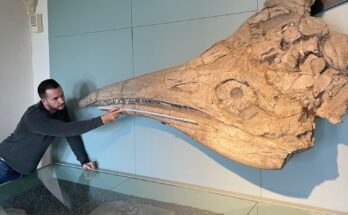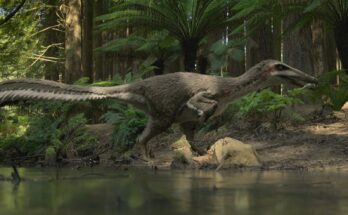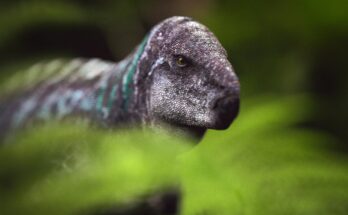✅ Part 1: Introduction – The Legend of the Tasmanian Tiger
In the dense forests and windswept plains of Tasmania, whispers of a striped ghost echo through the trees. Locals speak of quick glimpses in the underbrush — a long, dog-like animal with a stiff tail and a tiger-striped back. Some believe it’s extinct. Others say it still lives in hiding. But nearly everyone agrees: the story of the Tasmanian Tiger, also known as the Thylacine, is one of the most haunting and unforgettable wildlife tales in history.
The Tasmanian Tiger wasn’t a tiger at all. It was a carnivorous marsupial, related to kangaroos and wombats, but built like a dog. With its slender body, strong jaws, and striking black stripes, the Thylacine was unlike any other animal on Earth. It once roamed across mainland Australia, New Guinea, and Tasmania, hunting kangaroos and other small prey under the cover of night.
But then came humans.
The story of the Thylacine is a tragic one: a unique predator driven to extinction not by natural forces, but by fear, ignorance, and greed. Farmers, colonists, and bounty hunters declared war on the species, blaming it for killing livestock. The government even paid rewards for every Thylacine killed. By the early 20th century, only a handful remained — and in 1936, the last known Tasmanian Tiger died alone in a zoo.
Yet the Thylacine refuses to be forgotten. Over the years, thousands of unconfirmed sightings have kept the legend alive. From blurry photos to mysterious footprints, the search for a surviving Thylacine has become one of the most compelling wildlife mysteries of all time. Scientists have even begun cloning efforts, hoping to bring this ghost of the past back to life.
In this article, we’ll explore the full story of the Tasmanian Tiger — from its ancient beginnings to its heartbreaking extinction, and the efforts today to rediscover or even resurrect it. This is the tale of an animal that was more than just a marsupial. It was a symbol of the wild, of the unknown, and of how fragile life can be.

🐾 Part 2: What Was the Tasmanian Tiger? (Anatomy and Behavior)
The Tasmanian Tiger, or Thylacine (Thylacinus cynocephalus), was one of the strangest animals to ever walk the Earth. Although it looked like a wild dog with tiger-like stripes, it was not a dog or a tiger at all. It was a marsupial — a group of mammals best known for species like kangaroos and koalas that carry their babies in pouches.
But the Thylacine was different. It was the largest known carnivorous marsupial of modern times and had evolved into a top predator. This is why it’s often called a “marsupial wolf” or “Tasmanian wolf.” Let’s take a closer look at what made the Thylacine so unique.

📏 Size and Appearance
The Thylacine had a slim, elongated body with powerful jaws and a stiff tail. It stood about 60 cm (2 feet) tall at the shoulder, measured up to 1.8 meters (6 feet) long, including its tail, and weighed between 20 to 30 kilograms (44–66 lbs).
Key physical features included:
- Yellowish-brown fur with 13 to 21 dark stripes on the back and rump.
- A long, narrow snout with a powerful bite.
- Rounded, upright ears, perfect for hearing in the wild.
- A tail like a kangaroo’s — stiff and thick at the base.
- A pouch for carrying young — and here’s the surprise: males also had a pouch to protect their testicles while running through rough terrain.
While its stripes reminded people of a tiger, its general body shape was more like a medium-sized dog — giving it a very misleading appearance.
🧬 Marsupial Identity
One of the most important facts about the Thylacine is that it was not a placental mammal like dogs, cats, or wolves. It was a marsupial, which means it gave birth to tiny, underdeveloped young that crawled into the mother’s pouch to grow and nurse.
This made the Thylacine an incredible example of convergent evolution — where unrelated species evolve similar traits. Though not related to dogs or wolves, the Thylacine looked and behaved like them because they filled the same ecological role in Australia and Tasmania.

🐾 Behavior and Lifestyle
The Thylacine was nocturnal and solitary. It likely hunted alone at night and rested during the day in caves, hollow logs, or dense underbrush.
Diet:
The Thylacine was a carnivore and its diet likely included:
- Wallabies and kangaroos
- Small mammals like bandicoots and possums
- Birds and reptiles
- Carrion (dead animals)
It hunted by stalking and ambushing prey, rather than chasing it over long distances. Its jaws could open incredibly wide — up to 120 degrees — allowing it to take down prey with powerful bites.
🎤 Unique Features That Set It Apart
Here are some amazing and unique things about the Thylacine:
| Feature | Description |
|---|---|
| Jaw Structure | Could open its mouth extremely wide — much wider than any dog or cat |
| Pouch in Both Sexes | Females had a pouch for young; males had a protective pouch as well |
| Stripes | The dark stripes on its back helped it camouflage in forests and grasslands |
| Silent and Stealthy | It made little to no noise, which made it harder to spot in the wild |
| Feet and Toes | Had non-retractable claws and walked more stiffly than dogs |

🧠 Intelligence and Temperament
Although the Thylacine was smart and adaptable, it was not aggressive by nature. Most historical records describe it as:
- Shy
- Cautious around humans
- More of a scavenger than a bold hunter
Farmers often blamed the Thylacine for killing livestock, but some scientists believe this was exaggerated, and that feral dogs or poor farm management were more likely responsible.
👣 How It Moved
The Thylacine had a unique way of moving. Unlike dogs, which gallop or trot, the Thylacine could:
- Hop like a kangaroo when startled
- Stiffen its tail and use it for balance
- Stand upright briefly on its hind legs, possibly to scan its surroundings
These features made it a very unusual and versatile hunter in its environment.
🗣️ Did It Make Sounds?
The Thylacine was generally quiet, but some reports mention that it could make:
- Yapping or coughing barks
- Low growls
- Hissing sounds, especially when threatened
No known audio recordings of the Thylacine exist, so we still don’t know exactly what it sounded like.
🎯 Summary: A Hunter Like No Other
The Thylacine was a perfectly adapted predator for its time and place. It filled the same role as wolves and foxes in other parts of the world — but it was uniquely Australian in every way. A quiet, striped, dog-like marsupial with a pouch, a wide mouth, and a mysterious way of life.
It was beautiful, strange, and completely unique — and sadly, it would soon face challenges that it could not survive.


